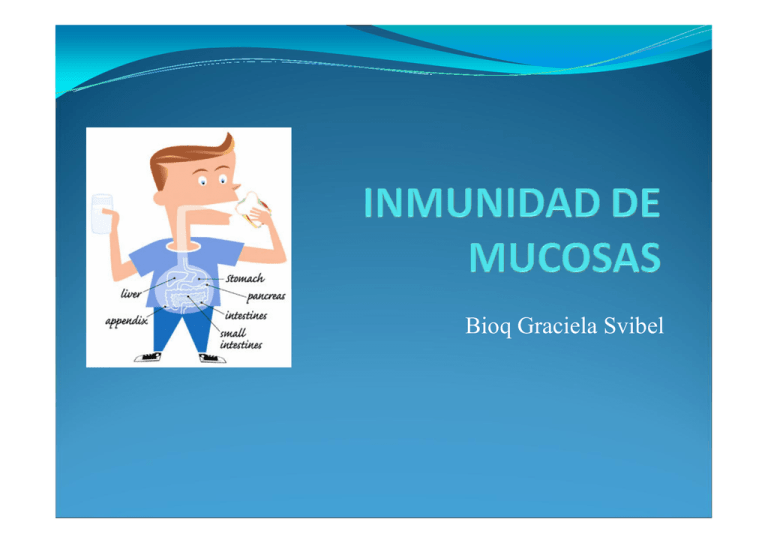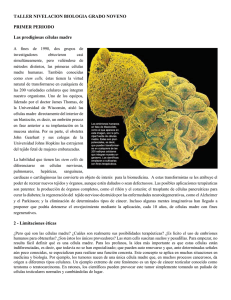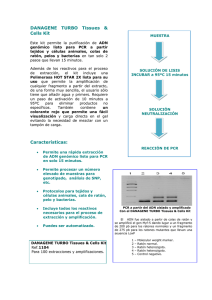INMUNIDAD MUCOSAS
Anuncio

Bioq Graciela Svibel Órganos linfoides Subepithelial dome (SED) Isolated lymphoid follicles (ILFs) -IEL are divided into two groups on the basis of which form of CD8 is expressed : ㆍtype a : CD8αβ αβ heterodimer, αβ TCR conventional T cell. ㆍtype b : CD8αα αα homodimer, αβ TCR or γδ TCR T cells. CCR9 ⇔ CCL25 : in the small intestine CCR10 ⇔ CCL28 : in the large intestine, salivary glands Propiedades de IgA secretora * Resistencia a proteólisis bacteriana. * Unión a pieza secretora y transporte a través del epitelio. * Acción anti-inflamatoria. * Mediación funcional por FcR. * Bloqueo/neutralización patógenos. In human, two isotypic forms IgA1, IgA2 ㆍIn blood, IgA1 : IgA2 ⇒ 10:1 : mainly monomer ㆍIn mucosal , IgA1 : IgA2 ⇒ 3:2 : mainly dimer Mucosal Immunology (2008) 1, 11–22. B-cell homing to mucosal and peripheral tissues is mediated by specific combinations of chemokine receptors and adhesion molecules. Newly developed B cells express specific chemokine receptors that mediate responsiveness to chemokine ligands expressed in secondary lymphoid tissues, bone marrow (BM), and mucosal effector sites. Within secondary lymphoid tissues, B cells encounter specific antigen leading to their activation and differentiation. In general, activation of B cells and differentiation to mucosal IgA antibody-secreting cells (plasmablasts and plasma cells) induce upregulation of CCR10 and expression of α4β1 integrin, which mediate attraction to CCL28 and VCAM-1, respectively. Expression of VCAM-1 in effector sites is indicated, although the expression of vascular adhesion molecules (like VCAM-1) at various effector sites is not yet systematically worked out. Differentiation of IgA plasmablasts within small intestinal lymphoid tissues additionally induces upregulation of CCR9 and α4β7 and directs homing back to the small intestine, which expresses CCL25 and MAdCAM-1. In contrast, differentiation to IgG plasmablasts of systemic type leads to upregulation of CXCR3, allowing responsiveness to CXCL9 and CXCL10 and migration to inflamed mucosal and non-mucosal tissues. Homing to the bone marrow is mediated through CXCR4, which is expressed on all types of plasmablasts, as well as CCR10. Memory B cells (not shown) retain expression of CCR7, CXCR5, and CXCR4 to allow their recirculation through lymphoid tissues. Retained expression of CCR7 and CD62L on effector B cells from tonsils/NALT may explain their joint tropism for organized lymphoid tissue and the upper aerodigestive tract (not shown). Specific chemokine–chemokine receptor pairs are indicated by corresponding colored text; specific integrin–ligand pairs are depicted by gray and yellow boxes. Bold text indicates the molecule is expressed on lymphocytes; text in italics indicates expression on endothelial or stromal cells. BALT, bronchus-associated lymphoid tissue; CCL, CC-chemokine ligand; CCR, CC-chemokine receptor; CXC-chemokine ligand; CXCL, VCAM-1, vascular cell-adhesion molecule-1; CXCR, CXC-chemokine receptor; MAdCAM-1, mucosal addressin cell-adhesion molecule-1; MLN, mesenteric lymph nodes; NALT, nasopharynx-associated lymphoid tissue; PP, Peyer's patches; PLN, peripheral lymph nodes. Activated B cells upregulate expression of activationinduced cytidine deaminase (AID), which is an absolute requirement for class-switch recombination and somatic hypermutation (SHM). The factors that are secreted by lamina-propria stromal cells (SCs), such as interleukin-6 (IL-6), IL-10 and transforming growth factor- (TGF-), favour not only preferential classswitching to IgA (c), but also the differentiation of antigen-selected cells to IgA+ plasma cells (PCs). A duodenal segment of the small intestine from an AID-deficient mouse showing many protruding follicles. b | These follicles consist of IgM+ B cells on a follicular dendritic cell (FDC) network (IgM, red; FDC, green). Using Monoclonal Antibodies to Prevent Mucosal Transmission of Epidemic Infectious Diseases Proteínas antimicrobianas en Mucosas Lisozima Degrada PG de la pared celular Lactoferrina Depriva de Fe++ Aglutininas Aglutinan y agregan microbios Péptidos antimicrobianos Defensinas Colectinas s a n i s n e f De • Péptidos catiónicos de 29–34 aa. •Se comportan como antibióticos naturales de amplio espectro. •Tienen regiones polares e hidrofóbicas separadas: forman poros multiméricos. •Atacan la estructura o función de la membrana celular (aniónica) de muchas bacterias y hongos •Su síntesis es aumentada por infecciones (LPS) o por citoquinas inflamatorias. •Estimulan la inflamación. •Son quimiotácticos para células de la respuesta inmune adaptativa. s a n i t c e l Co •Familia de péptidos antimicrobianos con estructura similar al colágeno. •Son lectinas que unen manos. •Activan complemento por vía clásica en ausencia de anticuerpos. •Facilitan la fagocitosi. El tejido linfoide asociado a las mucosas incluye: SITIOS INDUCTIVOS:PROCESAN LOS ANTÍGENOS Y SE INICIA LA RESPUESTA INMUNITARIA. SITIOS EFECTORES: FORMACIÓN DE ANTICUERPOS Y RESPUESTA MEDIADA POR CÉLULAS. Integrin αEβ7 is expressed by IELs and interacts with E-cadherin Sitios EFECTORES Sitios INDUCTORES CCL25 is also involved in the migration of lymphocytes to the intestinal mucosa ; its receptor CCR9 is expresed by almost all lymphocytes of the small intestine. La producción de anticuerpos contra los alimentos es un fenómeno mundial tanto en adultos como en niños saludables. En su mayoría son de isotipo IgG sin embargo no activan al sistema inmune. No están involucrados en fenómenos alérgicos…….. Oral Tolerance : to food antigens & commensal bacteria Responsive to Pathogens La TOLERANCIA ORAL es el mecanismo natural que el sistema inmunológico usa para permitir el proceso de la nutrición sin provocar rechazos o reacciones de hipersensibilidad frente a los alimentos. En este mecanismo se encuentran involucrados tejido linfoideo intestinal, entre ellos: las placas de Peyer, células epiteliales de las vellosidades, linfocitos intraepileliales y linfocitos diseminados a través de la lámina propia. Por cualquiera de los métodos por los cuales se induzca el efecto de tolerancia oral, es un proceso inmunológico natural que puede ser empleado con éxito en el tratamiento de las patologías autoinmunes. a | Mice that are immunized subcutaneously and then boosted subcutaneously with antigen plus adjuvant, such as Freund’s complete adjuvant or alum, show a robust in vitro cell-mediated and antibody response to the immunizing antigen. b | Mice that are first orally fed antigen, then immunized subcutaneously with antigen plus an adjuvant have reduced immune responses to that antigen after in vitro restimulation. c | Finally, T cells from mice that are fed antigen (low dose) can be transferred to naive mice. Immunization of mice that received the tolerized T cells results in the same reduced response as seen in the mice that were fed antigen orally. This shows that oral feeding of antigen can induce an active (but inhibitory) immune response that is mediated by T cells. Nature Reviews Immunology 4, 407-419 (June 2004) Different types of regulatory T cells. (1) CD4+CD25+ Foxp3+ Tregs are a naturally occurring Treg subset that is mainly thymus derived. (2) CD4+CD25+ Tregs are central in the prevention of autoimmunity; they were originally identified by the development of autoimmune gastritis in neonatally thymectomized mice. (3) In the intestine, dietary antigens and the commensal flora present an enormous antigenic load to the gut-associated lymphoid tissue. CD4+CD25+TGF-β+ Tregs and IL-10secreting TR1 cells are induced by unique subsets of APCs and provide overlapping layers of immunosuppression that prevent chronic intestinal inflammation. Nature Immunology 5, 119 - 122 (2004) Es un líquido amarillento espeso que contiene gran cantidad de Proteínas y Minerales y posee menos Grasa e Hidratos de Carbono que la leche Madura. Entre las proteínas, las más importantes son las INMUNOGLOBULINAS, especialmente la IgA secretoria, capaz de reconocer los microorganismos del entorno inmediato. Sin embargo no lo protege de las bacterias comensales del intestino. intestino Además contiene: LACTOFERRINA que fija el Fe en forma reversible y ejerce un efecto bacteriostático. PROTEÍNA FIJADORA DE LA B12 que reduce la cantidad de B12 disponible para el crecimiento bacteriano. OLIGOSACÁRIDOS que impiden que las bacterias penetren en el interior de las células. MUCINAS que se unen a Bacterias y Virus y ayudan a eliminarlos del organismo. FACTOR BÍFIDO que promueva el crecimiento de Lactobacilos Bífidus, que son Bacterias favorecedoras e inocuas que impiden el crecimiento de otras Bacterias dañinas. INF-γγ potencia la actividad Antimicrobiana de las células Inmunitarias. LISOZIMA que destruye las Bacterias al disgregar sus paredes celulares. El Calostro contiene también Factores Celulares: Macrófagos y Linfocitos. Los Macrófagos hacen de presentadores de Antígenos. Los Linfocitos pueden ser B o T. Los B son los productores de Ac y los T destruyen directamente las células infectadas. For newborn babies, human milk hastens the development of the gut and immune systems, which are immature at birth. Breast milk reinforces the barrier function of neonatal gut epithelium and provides the principal source of secretory IgA antibodies during the first months of life. These antibodies bind to food antigens to limit the reactivity of the immune system and to microbial antigens to retard infection. Babies who consume only breast milk for at least four months tend to experience less asthma and eczema, particularly if they have a family history of allergy. Después del Calostro viene la Leche de Transición y luego la Leche Madura, ambas van aumentando su contenido en Hidratos de Carbono y Grasas, pero el contenido de Factores Inmunológicos sigue siendo muy elevado. La Ig de la leche materna tiene actividad frente a la mayor parte de Bacterias y Virus; en particular Bacilo Tetánico, Diftérico, Estreptococo, Estafilococo, Neumococo, Poliovirus, Virus Coxakie, Echovirus, Virus Gripales, Rotavirus y Virus Respiratorio. Las últimas investigaciones avalan el hecho de que el pecho es el único lugar, fuera del sistema Inmunológico (Médula Ósea y Ganglios Linfáticos) que es capaz de sintetizar Anticuerpos localmente. La lactancia materna no solo proporciona la Inmunidad Pasiva sino que también tiene un importantísimo papel en la Inmunidad Activa. La leche materna tiene un alto contenido de Nitrógeno no Proteico; los Ácidos Nucleicos, Nucleósidos y Nucleótidos forman parte de este Nitrógeno No Proteico y desempeñan un papel muy importante en la maduración del Sistema Inmunitario, propiciando así la Inmunidad Activa a largo plazo. Además de todos estos factores medibles en la leche materna, existe también un punto muy importante a considerar en ello, es la repercusión del fuerte VINCULO MATERNO INFANTIL (que se crea en la lactancia materna) sobre la Inmunidad. Contiene lactoalbúmina y lactoferrina (60%) Aminoácidos como taurina, esencial para el desarrollo del SNC y triptófano, predecesor Algo más de leche materna…. serotonínico. IgAs que evita la invasión de las mucosas y anticuerpos contra antígenos del medio ambiente (Ecoli, V cólera, Salmonella, Shigella, Streptococos del grupo B, Neumococo, Klebsiella, Hinfluenza, Rotavirus, VSR, PV, Rubeóla) Lisozima Lipasa Caseína: promueve el desarrollo del factor bífidus que promueve el desarrollo del lactobacilus bífidus en el intestino del lactante, actúa también en la absorción del calcio y en la función plaquetaria. Ácidos grasos de cadena larga poliinsaturados; ácidos grasos de cadena mediana, colesterol y fosfolípidos. Lactosa, junto con el factor bífidus favorece la implantación de la flora acidófila. También hay cantidades muy pequeñas de glucosa, oligosacáridos y glicoproteínas que participan en la formación de la flora acidófila. Minerales, alcanzan 1/3 de la concentración en la leche de vaca: esto es beneficioso, pues al tener menor osmolaridad, disminuye la carga renal de solutos, lo que es especialmente importante en el caso del sodio. Complemento, Interferón, LT, LB, monocitos. La lactancia disminuye la incidencia de enfermedades en el niño: INFECCIOSAS: SEPSIS NEONATAL, DIARREA AGUDA O CRÓNICA, IU, MENINGITIS, OMA, INFECCIONES RESPIRATORIAS AUDAS, PARASITOSIS. METABOLICAS Y CARENCIALES: HIPOCALCEMIA DEL RN, DESHIDRATACION HIPERTÓNICA, ANEMIAS, DESNUTRICION, DBT INFANTOJUVENIL. GASTROINTESTINALES: ENTEROCOLITIS NECROTIZANTE, ENFERMEDAD CELÍACA, ESTENOSIS HIPERTROFICA DEL PILORO DERMATOLOGÍCAS: ATOPIA, ECZEMA INFANTIL, DERMATITIS AMONIACAL ODONTOLÓGICAS: MALA OCLUSIÓN DENTAL, PALADAR OJIVAL, CARIES. Antimicrobial factors Growth factors secretory IgA, IgM, IgG lactoferrin lysozyme complement C3 leucocytes bifidus factor lipids and fatty acids antiviral mucins, GAGs oligosaccharides epidermal (EGF) nerve (NGF) insulin-like (IGF) transforming (TGF) taurine polyamines Cytokines and anti-inflammatory factors Digestive enzymes tumour necrosis factor interleukins interferon-γγ prostaglandins α1-antichymotrypsin α1-antitrypsin platelet-activating factor: acetyl hydrolase amylase bile acid-stimulating esterase bile acid-stimulating lipases lipoprotein lipase Hormones Transporters feedback inhibitor of lactation (FIL), insulin,prolactin,thyroid hormones, corticosteroids, ACTH, oxytocin, calcitonin, parathyroid hormone, erythropoietin lactoferrin (Fe) folate binder, cobalamin binder, IgF binder, thyroxine binder, corticosteroid binder ¡DALE…. “AMAMANTAR ES UN DERECHO, LA DECISIÓN DE EJERCERLO O NO, DEBE SER LIBRE, PERO INFORMADA Y CON LA DEBIDAD CONTENCIÓN Y RESPETO EN TODOS LOS CASOS”. ¡DAME



